Stall and Fatal Crash at Houston Hobby
On the 9th of June 2016, a Cirrus SR20, registration N4252G crashed during a go-around at William P. Hobby airport, killing the pilot and two passengers.
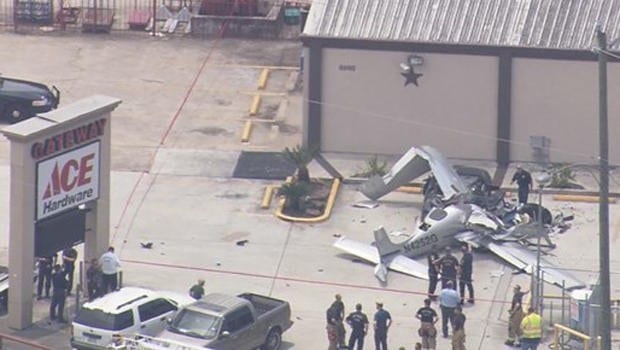
I first heard of this accident as a result of the AOPA Air Safety Institute’s video series although it happened a few years ago. I recommend the video but of course I wanted to get in deeper and try to understand better what happened. This is based on the NTSB Report CEN16FA211 and the ATC group report in the NTSB docket, both of which are available on the on the NTSB website.
The pilot had completed her PPL just over two years before, in 2014. The FAA requires a flight review every 24 months and hers was a month over due, however everything else was in order.
She planned the flight to Houston’s William P. Hobby Airport (HOU), Houston’s oldest commercial airport. She had two passengers on board, her husband and her brother-in-law. As HOU is just seven miles from downtown Houston, it was the closest airport for them to visit a family member who was undergoing cancer treatment at a local hospital.
This was probably her first trip to Houston Hobby Airport, a high traffic airport and a hub for Southwest Airlines. According to her log book, she had landed in Class B airspace four times, most recently with a landing and take-off at Dallas Love Field in Texas the week before.
On that day, the pilot and two passengers departed Oklahoma Westheimer airport at 10:11 local time and flew south to Houston. She contacted Houston Approach with the current ATIS information and was told to descend to 5,000 feet and maintain VFR. The flight received routine VFR handling and after descending to 1,800 feet, the approach controller told the flight to expect a left base to the traffic pattern for runway 4.
HOU Approach: You’re following a Boeing 737 about one o’clock and five miles…on a four mile final at 2,000. Caution for wake turbulence.
This is informational: the Boeing 737 is on approach and the Cirrus SR20 should make visual contact and be careful not to approach too closely, as the wake turbulence from the larger aircraft could be dangerous for the Cirrus. The strength of the wake turbulence is governed by the weight, speed and wingspan of the generating aircraft, in this case the Boeing 737. Aircraft are put into categories determined by their gross weight (although technically the best classification system would be wingspan) with minimum wake-turbulence separation distances established based on the categories of the leading and the following aircraft.
The pilot confirmed that she had the other aircraft in sight. The approach controller instructed the pilot to fly a heading of 095° in order to shorten the approach and then asked her to change frequency to Houston Hobby Tower. He then asked the Boeing 737 to reduce its speed and then also to change frequency to Tower. He continued to monitor their spacing.
At 12:52, the pilot contacted Houston Hobby Tower. At that time, the station was manned by a trainee with an instructor. “Tower” or “local control” is the air traffic control station responsible for active runway surfaces: they clear aircraft for take-off and landing, ensuring that separation is maintained at all times. Tower control works with Approach and with Ground in order to maximise traffic flow and ensure spacing between inbound and outbound aircraft. If the Tower controller detects any unsafe conditions, they may instruct a landing aircraft to go around and then be re-sequenced, which could mean transferring the aircraft back to Approach to circle around and start again.
The Cirrus SR20 pilot identified herself as N4252G and inbound to land. The trainee misunderstood the pilot’s initial contact and thought that the call came from an inbound 737, Southwest Airlines flight 235, which he cleared to land. Once the instructor pointed out the confusion, the trainee called back to clarify.
Trainee Controller: Cirrus 4252G, Hobby Tower. You’re number 2 following a 737 on a 3 mile final, caution wake turbulence. Runway 4 cleared to land.”
This made Southwest Airlines flight 235, who called in next, number three to land. It was clearly busy but nothing out of the ordinary for Houston Hobby airport.
The Cirrus pilot read back the instruction, at which point the trainee asked where she would be parking.
Cirrus N4252G: We’ll be parking at MillionAir.
Trainee Controller: Cirrus 4252G proceed direct to the numbers, you’re going to be inside a 737 intercepting a 10-mile final.
Proceed direct to the numbers is a reference to the threshold numbers on the runway: instead of following the rectangular pattern known as a circuit, the pilot should fly directly to the threshold of the runway ready for landing. This is common for light aircraft at large US airports, where there isn’t a lot of point in a single engine plane following the same pattern as a massive twinjet airliner. The request is most commonly used to try to get a slower aircraft to land and clear the runway quickly so that it is out of the way of an inbound jet. At the same time, ATC shortened the call sign for the Cirrus to N52G for faster reference. I will do the same.
Cirrus N52G: OK, you’d like me to proceed direct to the numbers, 4252G?
Trainee Controller: November 52G, what did approach tell you before?
Cirrus N52G: Um, to left base runway 4 and follow the Boeing.
Trainee Controller: …proceed direct the numbers for runway 4, direct to Hobby.
Meanwhile, the approach controller who handed her over to tower was working five or six other aircraft but he noticed that the Cirrus was still heading toward the outer marker, that is, still following the rectangular pattern rather than cutting the corner to the runway. He called the tower to ask them to turn the aircraft directly to the runway. He also wanted the Cirrus out of the way of the much faster Boeing 737, which was gaining on her. If the Cirrus didn’t land quickly, Southwest Airlines flight 235 would have to go around and approach again.
Tower staff confirmed that they’d already done this and the trainee contacted the Cirrus again. He instructed her to maintain maximum forward speed and proceed direct to the numbers, explaining that there was a Boeing 737 on 9-mile final following her and 80 knots faster than her.
Clearly this was to put the pressure on for her to get a move on, but the pilot remained calm, responding that she would proceed direct to the numbers and keep her speed up.
The trainee controller then broadcast to all aircraft that the ATIS (automatic terminal information service) had updated to information India. This is a small thing and there was no need to acknowledge, but for a pilot with not a lot of experience at major commercial airports, it seems clear that things were starting to pile on.
Southwest Airlines flight 235 contacted Houston Hobby to say they were on five mile final for runway 4. The trainee controller responded that Southwest was number two following a Cirrus on two-mile final, clearing the flight to land and asking him to slow to final approach speed.
The trainee controller then broadcast a wind check: 080° at 13 knots gusting to 18 knots. The wind was blowing down runway 4, perfect for landing.
The Tower instructor and the trainee discussed whether the spacing would work as the spacing between the Cirrus and the Boeing 737 behind it was decreasing. The instructor knew that runway 35 was also available for landing and so rather than send the Cirrus back out to approach for re-sequencing, he thought it would be better for the pilot to go around and use runway 35 instead. Rather than leave it to the trainee, he called the Cirrus himself.
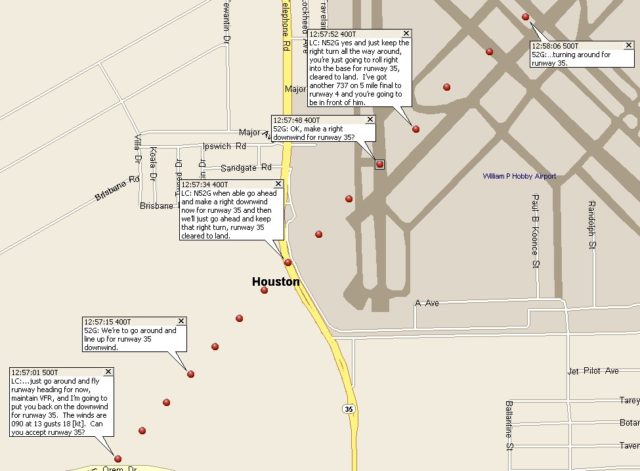
Tower Instructor: Yeah, I’ve got traffic behind you, just go around and fly runway heading for now, maintain VFR, and I’m going to put you back on the downwind for runway 35. The winds are 090 at 13 gusting 18. Can you accept runway 35?
Cirrus N52G: We’re to go around and line up for runway 35 downwind.
The instructor instructed the pilot to go ahead and fly runway heading 4 for now, that is, carry on straight long the runway, with the implication that she she shouldn’t worry about setting up for the runway 35 approach yet. The Cirrus pilot read the instruction back and, with the Cirrus safely out of the way, the instructor cleared Southwest flight 235 to land.
Tower Instructor: N52G, when able, go ahead and make a right downwind turn now for runway 35 and then we’ll just go ahead and keep that right turn, runway 35 cleared to land.
Cirrus N52G: OK, make a right downwind for runway 35?
Tower Instructor: N52G, yes, and just keep the right turn all the way around, you’re just going to roll right into the base for runway 35, cleared to land. I’ve got another 737 on five-mile final to runway 4 and you are going to be in front of him.
Cirrus N52G: turning around for runway 35.
Tower Instructor: Just enter the downwind for runway 35.
I’m pretty sure I’d be stressed out trying to follow these instructions, knowing that now another Boeing 737 was bearing down at me, but the pilot continued to respond calmly. The Tower controller told her that he would call the right base turn. Effectively, he’s planning to get the Cirrus down on runway 35 through a gap between the arrivals on runway 4.
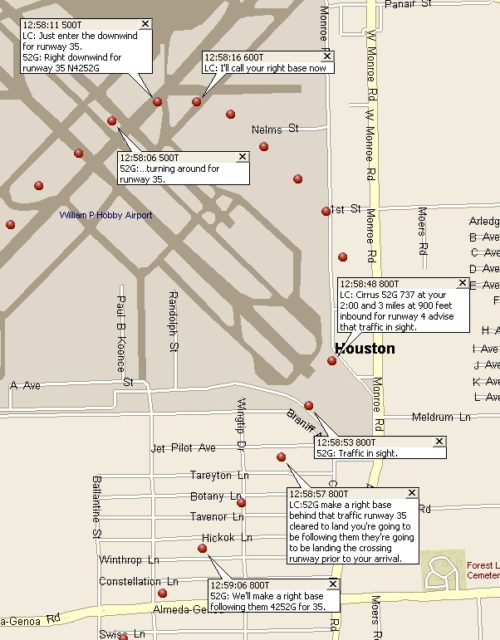
At this point, the trainee controller took over and contacted the pilot with a traffic advisory: another Boeing 737 inbound to runway 4. The pilot confirmed she had the 737 in sight. The trainee controller then instructed the pilot to make a right base turn to follow (in this context meaning pass behind) the 737 and again cleared the pilot to land on runway 35.
Cirrus N52G: We’re going to make a right base following them…for runway 35, N4252G.
The instructor, watching on radar, realised that the Cirrus was overshooting and not properly lined up for runway 35. He became concerned about loss of separation with Southwest flight 235 which was coming in to land on runway 4.
The trainee controller told the pilot to turn left heading 30°, in order to resolve the possible conflict. It’s not clear if the controller meant that the Cirrus should turn left by 30° or to turn to a heading of 30°. The pilot read back the instruction but this time, she didn’t sound confident about what she was expected to do. The Tower Instructor took over and offered a new plan; he asked if the pilot would prefer to follow the 737 to runway 4.
Cirrus N52G: Yes, that would be great.
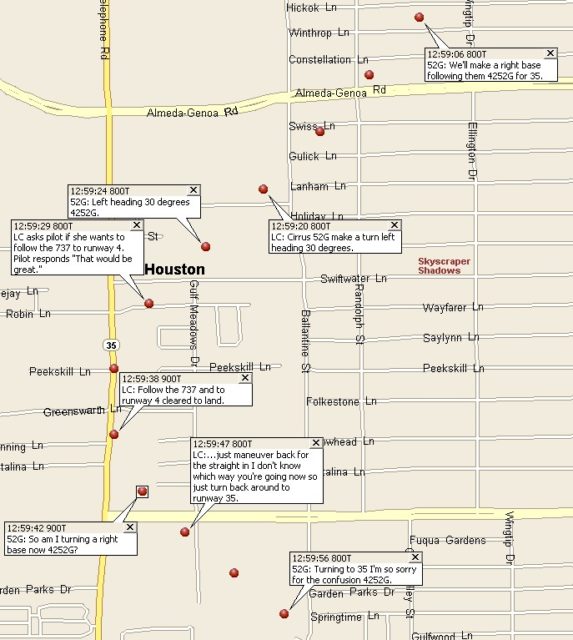
Note that’s a shift from runway 4 to runway 35 and then back to runway 4, all in less than two minutes. The pilot sounded like she was coping but this is definitely adding to overload in a busy airport during an already stressful phase of flight.
Cirrus N52G: Am I turning a right base now?
Tower Instructor: Roger, just maneuver back for the straight-in, I don’t know which way you’re going now, so just turn back around to runway 35.
Now, I’m sitting comfortably at a desk reading a transcript and I had to read that twice to understand that the controller had changed his mind, presumably as she didn’t react clearly enough, and was now asking her to line up for runway 35 again, this time for a straight-in, although he wasn’t clear what she was doing at that moment… while Boeing 737s seem to be flying all around her.
Cirrus N52G: Turning to 35, I’m so sorry for the confusion.
Tower Instructor: That’s OK, we’ll get it.
I need to say here, the confusion was not her fault. She’d perhaps misunderstood quite how to follow the 737 into runway 4 but she had been repeating and following instructions throughout. Meanwhile, the controllers seemed to treat her like a pinball, to be batted out of the way while they deal with the bigger aircraft.
About 30 seconds later, the Instructor asked the pilot which direction she was turning.
Cirrus N52G: I thought I was turning a right base for 35.
Tower Instructor: That’s fine, uh, just make it, uh, you say you’re in a right turn, keep it tight, I need you to make it tight.
Cirrus N52G: Keep turn tight.
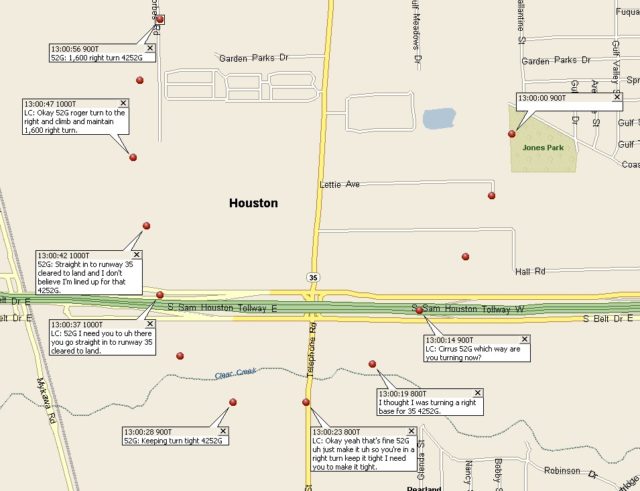
The controller then gave a general aviation traffic alert for traffic one mile away at 900 feet, referring to the Cirrus. Another aircraft reported that he was looking.
Tower Instructor: N52G, I need you to …there you go, straight in to runway 35, cleared to land.
Pilot: Straight in to runway 35 and I don’t believe I’m lined up for that.
This was the first time the pilot pushed back. The instructor acknowledged this by gave her a completely new instruction.
Tower Instructor: Turn to the right and climb and maintain 1,600, right turn.
Then, having broken off the approach, the controller tried again.
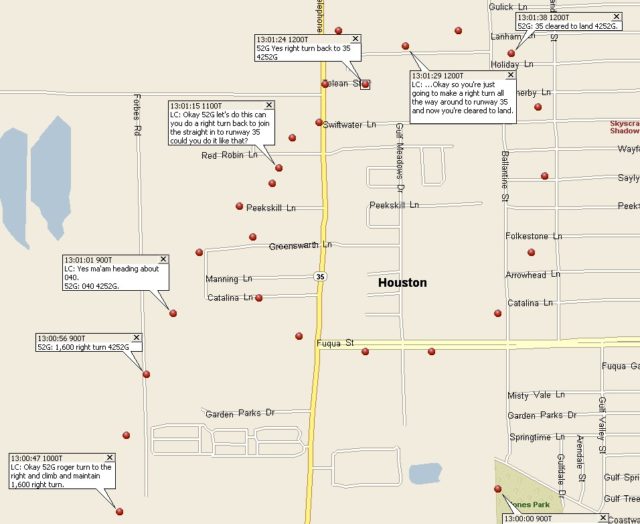
Tower Instructor: OK, 52G, let’s do this. Can you do a right turn back to join the straight-in to 35? Could you do it like that?
Cirrus N52G: Yes, right turn back to 35, N4252G.
He instructed the pilot to make a right turn all the way around to runway 35 and again cleared the pilot to land.
At the same time, the approach controller called the Tower to offer a space to put the Cirrus behind another aircraft, N4JJ, which was inbound and on final for runway 4. He got no response.
N4JJ contacted the tower on a visual approach to runway 4. The Tower Instructor told the pilot to reduce to minimum speed, advising that he would be number two for the airport, following a Cirrus on one-mile final for runway 35, which the pilot of N4JJ acknowledged.
Tower Instructor: Cirrus 52G, OK, you’re looking good. Just continue a right turn for runway 35. Do you see runway 35 still?
Cirrus N52G: Yes, 35, have it in sight, continuing my roll around.
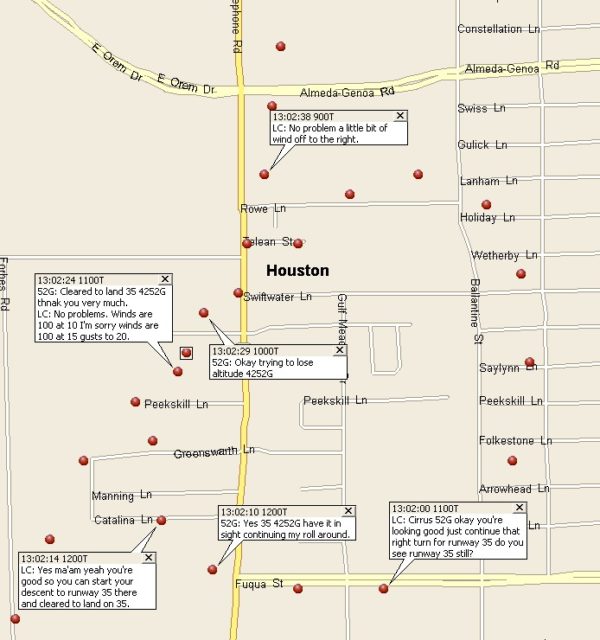
Tower Instructor: Yes, ma’am, yeah, you’re good so you can start your descent to runway 35 there, and uh, cleared to land on 35.”
Cirrus N52G: Cleared to land on 35, thank you very much.
Tower Instructor: …winds are 100 at 15 gusts to 20 [knots]
Cirrus N52G: OK, thank you. Trying to lose altitude.
Tower Instructor: No problem, little bit of wind off the right.
Tower Instructor: N52G, if you don’t want to land — if that’s too high, we can put you back around the downwind, don’t force it if you can’t.
Cirrus N52G: OK — we’ll see, thank you.
Tower Instructor: OK, I think you’re too high, Cirrus 52G, you might be too high.
Cirrus N52G: OK, we’ll go around then, N4252G.
The Tower Instructor told the pilot to make right traffic for runway 35. This means to join the right-hand circuit for runway 35 and the pilot responded that it sounded perfect and repeated the instruction.
As the Cirrus continued along the right-hand circuit, the Tower Instructor once again cleared the Cirrus to land.
Tower Instructor: …make right downwind to runway 35 and you are cleared to land. There will be no other traffic for runway 4 so this one will be easy.
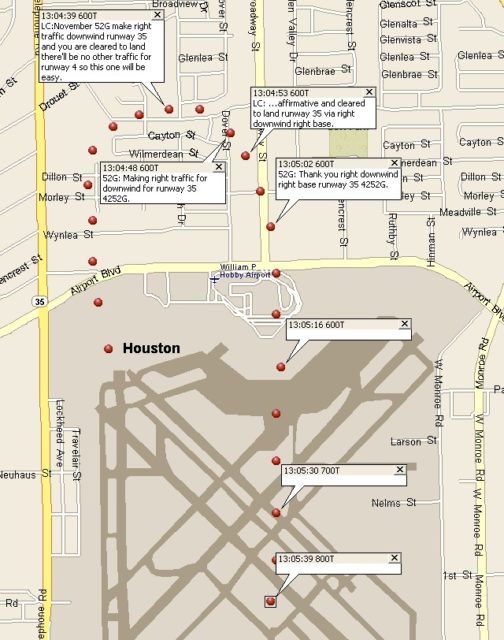
Preparing for second approach to runway 35
His words were at least an acknowledgement that it had not been easy so far. I know I might be projecting, as it’s easy to imagine myself in the position of the low-hours pilot trying to deal with a busy commercial airport in what was probably her first visit, so she was unlikely to really know the area or the patterns beyond looking at the charts that morning. It is all-to-easy to put myself in her place and feel the tension increasing.
Cirrus N52G: Making right traffic for downwind for runway 35.
Tower Instructor: Affirmative and cleared to land on runway 35 via the right downwind and right base.
Cirrus N52G: Thank you — right downwind, right base.
Tower Instructor: There’s a 737 on short final runway 4 touching down right in front of you so just caution wake turbulence right there at that intersection.
Cirrus N52G: OK, I’ve got that in sight.
The instructor controller asked if the pilot had the runway in sight and once she replied that she did, he provided a wind check. Landing on runway 35 meant landing into a bit of a crosswind but no one seemed bothered by this.
The Tower’s front line manager contacted approach and asked them to slow their next arrival down, in order to build a little more space for the Cirrus. However, final approach was “pretty full” up to about 20 nautical miles and the next aircraft was already at the final approach fix, so approach could not slow down the inbound aircraft. The approach controller thought that the Cirrus was landing on runway 4 and didn’t think that the Tower could get the Cirrus down before the next aircraft, so he offered to take the Cirrus back, effectively pulling her out of the pattern for a new approach. As the pilot was already turning base for runway 35, the front line manager replied that Tower would continue with the aircraft. The approach controller didn’t realise that the Cirrus was landing on runway 35 until she turned final.
Still sounding confident and collected, she acknowledged that she was too high once again. The Tower Instructor said later that having an aircraft miss the runway twice was very unusual but that as the aircraft was VFR, that is, flying visually, keeping it in the pattern was the normal response. It never occurred to him to transfer her back to Approach to start over.
At this point, there was a shift change. The trainee was asked to relieve the ground controller so that he could take over the local control from the instructor.
Cirrus N52G: Going around, third time will be a charm.
The new controller was relieved to see the Cirrus go around because it looked high and he was concerned that she wouldn’t touch down until the end of the runway. He said later that she sounded composed and in control as she prepared for another approach.
Tower Instructor: OK, Cirrus 52G, just go ahead and make the left turn now to enter the downwind, midfield downwind for runway 4. If you can just keep it in a nice tight low pattern, I’m going to have traffic four miles behind you, so I need you to just kind of keep it in tight if you could.
Cirrus N52G: OK, this time will be runway 4, turning left.
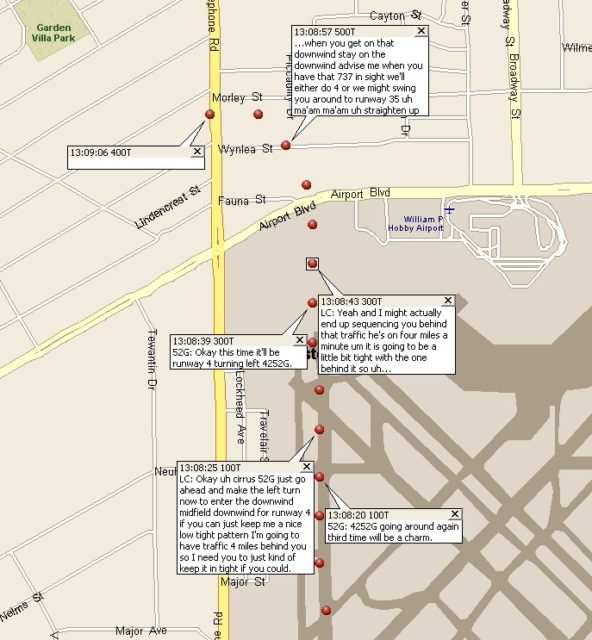
The controller’s plan was to have the Cirrus follow a 737 on final to runway 4 but he was also considering taking her to runway 35, depending on traffic.
Tower Controller: And actually, I might end up sequencing you behind that traffic, he’s on four miles a minute…um, it is going to be a bit tight with the one behind, so when you get on the downwind, stay on the downwind and advise me when you have that 737 in sight. We’ll either do [runway] 4 or we might swing you around to 35, uh…
He stopped as he saw the aircraft winging over and “going steep.”
Tower Controller: Ma’am, ma’am, straighten up. Straighten up!
He never received a response. The Cirrus crashed into a parking lot northwest of the airport at 13:08.
Putting the whole thing together, here’s the ground track of the flight over the course 15 minutes, from the time she contacted Tower:
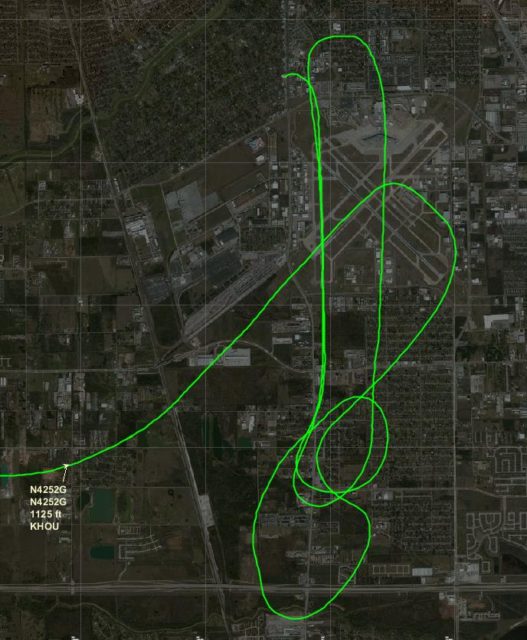
The pilot of the Cirrus had become so overloaded, she’d lost track of the airspeed of the aircraft. She became completely focused on following the latest instruction (or non-instruction, while the controller thought out loud about what he was considering) that she never even thought about the risk of a stall. As she turned away from runway 35, she retracted the flaps ready to turn and line up for another approach on runway 4… but it was too soon. When breaking off an approach, the pilot should have brought the Cirrus to 81-83 knots indicated airspeed before changing the configuration of the aircraft. The Cirrus published stall speed with flaps up is 69 knots. The pilot was only showing 58 knots indicated airspeed when she retracted the flaps.
Th Cirrus SR20, already low and slow, spun to the left. The nose dropped 45° and the Cirrus crashed into a hardware store parking lot. The Cirrus parachute rocket motor activated during the impact, much too late. The impact was not survivable.
The National Transportation Safety Board determines the probable cause(s) of this accident as follows:
The pilot’s improper go-around procedure that did not ensure that the airplane was at a safe airspeed before raising the flaps, which resulted in exceedance of the critical angle of attack and resulted in an accelerated aerodynamic stall and spin into terrain. Contributing to the accident were the initial local controller’s decision to keep the pilot in the traffic pattern, the second local controller’s issuance of an unnecessarily complex clearance during a critical phase of flight. Also contributing was the pilot’s lack of assertiveness.
If you want to hear the original radio and follow the sequence as a video, then I highly recommend the AOPA accident case study.
I’m not crazy about the contributing cause of a lack of assertiveness. The controllers and the pilot were all trying to achieve the same thing: get the Cirrus on the ground. She consistently sounded professional and composed on the radio, which controllers agreed led them to believe that she was confident and in control, but I don’t think you should hold good radiotelephony against a pilot. She could have specifically requested to be re-sequenced — transferring to approach as she flew away from the airport, so that they could bring her in again — but it would again mean fitting the slow Cirrus in between the Boeing 737s with the same issue of the larger planes gaining on her, so she may not have believed there would be any benefit.
Peter Garrison of Flying Magazine makes a further point.
Examining the Aftermath of the June 2016 Crash of a Cirrus SR20
A point that the NTSB does not mention is that a go-around from a full-flap approach is a delicate maneuver that pilots are seldom called upon to perform. A pilot making an instrument approach to minimums avoids using full flap, until landing is assured, for that very reason. It is quite possible that since her training, the pilot of the Cirrus had never had to perform such a go-around, and now, suddenly, she was given not one but three chances to fail.
I’m not saying she had no responsibility. It seems clear that the airport operations required her full attention and thus she lost track of the aircraft’s speed and configuration, reacting to the controllers’ instructions without acknowledging that she was unable to keep up with their demands.
Just, it’s so easy to see myself in this one and struggling on, never quite acknowledging that it has all become too much. It’s not like you can simply pull over and work out what you need to do or even just take a deep breath.
This is a tragic failure but also a classic one. The report covers the detail but what it doesn’t do is highlight points at which a different decision could have changed everything. I’ll leave that to you in the comments.








Sylvia, I do agree with you.
The instructions that were issued by ATC to this relatively inexperienced pilot eventually overwhelmed her. When reading this, I also agree that she was competent, but competent in the sense that it corresponded with her experience level. And, may I add, she probably had the potential to become a very fine pilot if this tragedy had not occurred.
What puzzles me, though, is the acceptance of a rather strong crosswind.
It would not have fazed a pilot in a larger aircraft, but for a light ‘plane like a Cirrus it may well have been close to the maximum. For the aircraft, I mean. And so it may well have been a “handful” for a private pilot with only a modest experience.
ATC’s way of handling this flight was also marginal. And I am not sure that the rather less formal way R/T is conducted in the USA is always such a good thing. In Europe, ATC instructions are much “crisper”, we do not really use phrases like “on the numbers”. Sorry, in France they are also less formal and in France I have had 3 of my 4 “near misses”.
The ratio of excess power available in the event of a go-around is to a large degree the determining factor of when “full” flaps will be used.
Again, in the USA procedures deviate from most other parts of the world. In Europe, a landing clearance is generally understood to mean that the runway is clear and fully available to the landing aircraft. Therefore, it is reasonably safe to apply full flaps after “clear to land”.
Not so in the USA, where a pilot can be told “N121C clear to land, no 9 in traffic, follow a Cessna 150”. N121C in that case was a Citation 550, following a C150 on downwind. It will therefore be up to the pilot to decide when (s)he will extend full flaps.OK, the same applies of course in Europe, but as mentioned, “cleared to land” means exactly that. It is a phrase that takes a lot of pressure away from the pilot.
Mind, I had a single-engine wave-off during my FAA check ride in the Citation when I first got my rating, if I remember well in 1971.
At about 50 feet, full flaps extended, one engine flight idle (simulated failure) the other one also just pulled back for landing, the examiner suddenly called “Go around”. He should not have done it, but he did.
As it turned out, he had been in the spotlight for passing a baseball player, Munson, who had not a lot of total time but bought a Citation and flew single pilot. He killed himself and his passenger (the news reports at the time mentioned “instructor”, but he had been instructing on light aircraft, not on jets. So the examiner got the “flack” for passing Munson and was determined to make sure that nobody would pass by him who had not been proven to be “on top” of the aircraft.
But that was not the case in this tragic Cirrus accident.
This pilot was let down by ATC, pure and simple.
Your point on the crosswind was my first reaction — 18 knots almost-directly crossing (with a slight tailwind component) seems like a lot for a plane slow enough that it stalls at just 69 knots clean. If the ground track is accurate, the pilot was maintaining a reasonable course during the go-arounds (possibly helped by the runway being a point of reference), but that’s simpler than putting the plane on the ground safely.
This does sound like an ATC screwup — possibly including keeping a trainee on the seat too long instead of the instructor saying “Watch how this is done.” ISTM that the first mistake was redirecting to runway 35; the plane would have had an easier course, less crosswind, and more stopping room (before crossing the landing path of a full-size jet) if brought around to runway 13.
Good GA pilot, this lady, was treated like the author says…a ping pong or pin ball….no wizards here either…but the larger question for the community if this is the treatment by controllers…who are thankfully still human…are that is it really appropriate for small GA flights into such busy airports…because the big planes simply don’t turn around so well…and neither do the Cirrus one’s that stall in tight turns at 70 mph
Chip,
Absolutely. Such a tragic accident and, with a bit of help from ATC totally avoidable. Your comment about the instructor is also very relevant.
The only possible redeeming factor (for the controllers) is that airports in the USA are very, very busy and ATC understaffed and overworked.
But my “redemption” does not exonerate, it only shifts the blame away from the humans in the tower and in the direction of the authorities.
It is a sign of the times. Not only in aviation, but also e.g. in the health sector where sometimes huge compensations are being paid. Money that could have been used to employ more staff and avoid tragedies.
If you would explain the difference between a small pland nad large plane/jet landing pattern that would be great.
Also I have no idea what this means. “updated to information India”.
Typo, “This was the first time the pilot pushed back. The instructor acknowledged this by gave her a completely new instruction.” “giving”.
Does ATC know how many hours each pilot has that they are speaking with? I think that is very useful information, and it sounds like a significant oversight if they are not aware of each and every pilot’s level of experience.
Mike,
A small aircraft may weigh in the order of 1000 kg. The cruise speed may be in the order of 160 mph and they approach typically at about 70 mph. Because of their relatively low weight and typically low wing loading, they are manoeuvrable and able to perform tight turns, they do not need a lot of airspace; if they must go around they can be put back into the pattern quickly. A piston engine picks up quickly when power is applied. At low power, if the aircraft increases speed – especially in the case of a variable pitch prop – the propeller will actually be a stabilising factor by delivering drag rather than forward power. A propeller aircaft is fairly flexible on the approach; if a bit high, just close power and the aircraft will just regain its proper path, if necessary all the way down to landing. The low mass will allow a “flare” even from a steep, power off descent.
But if needed, power can be restored quickly and the prop will instantly blow air over the wing surface, adding a bit of lift right when needed.
A jet transport is very different. Even a “medium” may have a mass 50 or 60 times that of the light aircraft. It is built for speed, so the wing loading will be much higher. In critical manoeuvres it will stall much more quickly. There is no propeller to provide a stabilising element in thr approach and the efficient wing is built for speed. A jet aircraft on the approach will tend to pick up speed if nothing else happens.
Usually, below 20,000 feet, the jet will slow down to a maximum of 250 knots. A “knot” is a unit of speed, one natical mile per hour or 1.852 km per hour, a “statute mile” is about 1.6 km.
The jet will, in the intital approach, usually be asked to slow down in increments, first 210 kts and when settled to 180 and finally 160 or less.
A typical approach starts at about 10 nautical miles’ distance from the runway, at 2000 feet. By then, the first application of flaps will have been selected.
A jet engine needs time to “spool up”, so the approach is not made at low power setting, instead at about 65 – 70%.
At the same time, the glide path is incercepted, the gear extended and flaps selected to keep the descent at an angle of about 3 degrees. A relatively high power setting means that the engines will be able to deliver power quickly if needed, the speed and the glide path are kept stable by the flap- and slat setting. At 140 kts, a typical jet approaches at the cruising speed of many light aircraft, the descent rate is usually in the order of 500 feet per minute. With the high power, if a go-around is required, a reduction in flap setting will allow it instantly to gain speed and climb away.
Big jets need a lot more space to go around. The cost of a go-around is high. Mainly for reasons of cost, the commercial jets will be pulled ahead of light aircraft. Airlines pay fortunes in landing, parking and other fees. At a big airport, one landing and the associated handling and other fees of a big jet would make a nice downpayment for a new car. If it is a 747, it may well be the equivalent of the new price of a nice car.
So: in short, a light ‘plane does not have a lot of mass, can easily manoeuvre, is relatively slow and can stay close to the airport. A jet, on the other hand, is faster. A lot faster. It needs to be on a stable approach path, also because its higher speed and much greater mass require a lot more landing distance.
ATIS: The latest weather information (visibility, cloud base, wind, altimeter setting etc.) is transmitted either via a dedicated radio frequency or broadcast on the VOR, which is a naviation beacon. Instead of listening to a three letter identification in morse code, the pilot will receive the ATIS. At major airports there is a departure- and arrival ATIS giving extra information about active runways and other useful data. The ATIS is updated on a regular basis, that can be hourly or half hourly, or more frequently in the event of major changes. With the ATIS an identifying letter is given. So: Alpha, bravo, charlie, delta, etc. So the pilot will call approach control with the call sign and the identfying letter of the ATIS, say “Paris, speedbird ( whatever flight number) with India”. The controller will know that the pilots have received the information with that particular code. If something has changed in the meantime, ATC may respond by saying something like “information kilo is current”. This will tell the pilots that something has changed between the time when they listned to the info and making contact. Sometimes, if the update was only the scheduled routine, the controller may say ” no significant change.”
Experience. This is a very astute question but: No, it is not really possible for ATC to know the experience level of each pilot with whom they are in contact. Experienced controllers will know from the way the R/T progresses whether the pilot is experienced or not. It must be assumed that private pilots in general are less experienced than commercial pilots and it could be expected that they will act supportively when dealing with a private pilot.
In this sad case, the pilot was composed and remained calm under stress. The controller was a novice and failed to understand that his actions, his instructions, would eventually overwhelm even a reasonably experienced pilot. Chip is right: the instructor, perhaps because of a high workload, missed a chance to “show the trainee how it’s done” which in the end had tragic consequences,
AFAIK, US ATC is not affected by the private-company disease of exectuives being massively paid to cut as much as possible the amount paid for frontline workers; since it’s all a government operation, there are strict limits on executive salaries. However, there was a non-monetary payoff: the long-standing crunch can be seen as a result of Reagan getting a political payoff from firing controllers when they struck. I lean distinctly left (at least by US standards), but have no sympathy at all for those controllers; they endorsed Reagan, a fundamentally stupid and unfit candidate, thinking that it would buy them tolerance for a labor action. Unfortunately, the rest of us are still paying the cost of rebuilding the pool of qualified controllers. Yes, all of the strikers would have retired by now — but the action did not encourage people to consider ATC as a career, and it’s not as if (e.g.) the police strike in my city (Boston) a century ago where the ranks were easily filled with demobilized soldiers returning from World War I; ATC takes serious skill and temperament, unlike policing at that time. (I know for one that I’d never be able to handle it; I hit my limit when I failed a compressed test for real-time broadcast engineering at my college radio station.)
Mike: one minor addition to Rudi’s excellent explanation: all planes leave turbulence behind them in the form of counter-rotating vortices that act like a pair of giant fans. A typical commercial jet is heavy enough that it can plow through what’s left of this disturbance if it’s 3 miles behind its predecessor, although more room is necessary behind really large planes (A380/B747 class). A small plane flying through this mess will either drop abruptly (if perfectly centered) or snap-roll (if slightly to one side — or if the vortices have been blown off-axis by a crosswind), so controllers usually have to allow more room for a personal plane behind a commercial plane. IIUC, sometimes they can make this up by having the \\next// commercial plane follow more closely (since it won’t be affected by the vortex of the small plane), but that requires precise judgment, and sometimes that the small plane effectively cruise all the way to touchdown instead of slowing on approach. You can see this at a busy airport — note that commuter planes commonly approach nose-down because they’re close to cruise speed, while larger planes approach nose-up because that lets them make a gentle descent despite flying at half or less the 500+ knots they cruise at.
Chip,
I am not sure where the comment about “executive pay” fits in. But traditionally, in the USA private aircraft are not usually charged much if anything at all. Much is absorbed by the taxpayer. In Europe landing, parking and handling fees, especially at big airports, can be a “king’s ransom”. In the ‘eighties a landing and handling at Heathrow for a small, 14 passenger Corvette could exceed £ 1000. And so airlines have been pushing for small aircraft to be relegated to regional airports, because a delay could cost another fortune. That might just have resulted in a missed slot at the gate, or a bowser that was sent off to refuel another jet first. Ground staff may have to react to the allocation of another gate, meaning that they have to announce and prepare for a gate change. Not just the passengers, also the stairs, baggage handlers, etc. At busy airports, all those things are planned in. I used to fly in and out of Heathrow on a regular basis, I think that corporate jets now go to Luton or Stansted. Maybe not even there any more.
Paris CDG was very restricive, so was ORY, LBG was the usual for private flights or one of the smaller airports like Toussus nearby.
Re wake turbulence: If you can imagine that essentially lift is generated by creating low pressure on top of the wing and higher pressure underneath, then you can visualise that at the wingtips the higher pressure in a way rolls upwards to compensate for the low pressure above.
This causes a vortex, a rotating funnel of air. As the aircraft, in the process of flying, moves forward, it created a long rotating cylinder, not unlke a “twister” but horizontal. In quiet air it can linger for many minutes. The air pressure inside the vortex is low. This lessens the capacity to hold water vapour which condensates. Often, in moisture-laden air you can see the vortex as ribbons trailing behind the wing tips. They drift downward so a following aircraft on a lower track can hit the turbulence. It is stronger at low speeds and only dispappears after touch-down. Wake turbulence from large jets can flip a light aircraft over if it passes a runway intersection where a light aircraft is at the holding point.
Propeller aircraft do tend to approach nose down, jets have a more pitch-up attitude. Nothing to do with trying to maintain cruising speed, if they did even an ATR or other turboprop would have problems trying to stop before the end of the runway.
It happened once to me in the Cessna 310. We got an expected approach time that would have kept us in the holding for about 45 minutes, when ATC told us “if you are able to maintain a minimum of 140 kts until the middle marker you are cleared for approach, otherwise you new expected aproach time will be . . ‘ if I remember well, they added another half hour. So I tore down the ILS and had to hold off landing because the speed was still too high to extend the wheels.
Frankfurt (EDDF) had a very long runway, but I was well past the first half before we touched down. As we left the runway at one of the last intersections the controller, before handing us to “ground” said: “Papa Tango Romeo (PH-STR), what do you think you are flying, a bloody Jumbo?”
Chip, the nose-up attitude of a turbo-prop and the high nose of a typical jet on the approach result from aerodynamic properties. The “gentle descent” is a standard three degree glide path. A typical approach speed with flaps and slats set for landing is in the order of 160 knots, slowing down past the outer market to Vref plus a compensation factor.
Vref may be in the order of 120 kts. The jets typically have a high power settng and high drag from the flaps, They control the speed with relatively small power corrections. Some have tail mounted speed brakes. They were first developed in the Fokker F28. The amount of drag could be controlled by the pilots, so they used them in lieu of changing the power.
Chip,
I am not sure where the comment about “executive pay” fits in. But traditionally, in the USA private aircraft are not usually charged much if anything at all. Much is absorbed by the taxpayer. In Europe landing, parking and handling fees, especially at big airports, can be a “king’s ransom”. In the ‘eighties a landing and handling at Heathrow for a small, 14 passenger Corvette could exceed £ 1000. And so airlines have been pushing for small aircraft to be relegated to regional airports, because a delay could cost another fortune. That might just have resulted in a missed slot at the gate, or a bowser that was sent off to refuel another jet first. Ground staff may have to react to the allocation of another gate, meaning that they have to announce and prepare for a gate change. Not just the passengers, also the stairs, baggage handlers, etc. At busy airports, all those things are planned in. I used to fly in and out of Heathrow on a regular basis, I think that corporate jets now go to Luton or Stansted. Maybe not even there any more.
Paris CDG was very restricive, so was ORY, LBG was the usual for private flights or one of the smaller airports like Toussus nearby.
Re wake turbulence: If you can imagine that essentially lift is generated by creating low pressure on top of the wing and higher pressure underneath, then you can visualise that at the wingtips the higher pressure in a way rolls upwards to compensate for the low pressure above.
This causes a vortex, a rotating funnel of air. As the aircraft, in the process of flying, moves forward, it created a long rotating cylinder, not unlke a “twister” but horizontal. In quiet air it can linger for many minutes. The air pressure inside the vortex is low. This lessens the capacity to hold water vapour which condensates. Often, in moisture-laden air you can see the vortex as ribbons trailing behind the wing tips. They drift downward so a following aircraft on a lower track can hit the turbulence. It is stronger at low speeds and only dispappears after touch-down. Wake turbulence from large jets can flip a light aircraft over if it passes a runway intersection where a light aircraft is at the holding point.
Propeller aircraft do tend to approach nose down, jets have a more pitch-up attitude. Nothing to do with trying to maintain cruising speed, if they did even an ATR or other turboprop would have problems trying to stop before the end of the runway.
It happened once to me in the Cessna 310. We got an expected approach time that would have kept us in the holding for about 45 minutes, when ATC told us “if you are able to maintain a minimum of 140 kts until the middle marker you are cleared for approach, otherwise you new expected aproach time will be . . ‘ if I remember well, they added another half hour. So I tore down the ILS and had to hold off landing because the speed was still too high to extend the wheels.
Frankfurt (EDDF) had a very long runway, but I was well past the first half before we touched down. As we left the runway at one of the last intersections the controller, before handing us to “ground” said: “Papa Tango Romeo (PH-STR), what do you think you are flying, a bloody Jumbo?”
Chip, the nose-up attitude of a turbo-prop and the high nose of a typical jet on the approach result from aerodynamic properties. The “gentle descent” is a standard three degree glide path. A typical approach speed with flaps and slats set for landing is in the order of 160 knots, slowing down past the outer market to Vref plus a compensation factor.
Vref may be in the order of 120 kts. The jets typically have a high power settng and high drag from the flaps, They control the speed with relatively small power corrections. Some have tail mounted speed brakes. They were first developed in the Fokker F28. The amount of drag could be controlled by the pilots, so they used them in lieu of changing the power.
Of course, I should have mentioned that wake turbulence is a cause of “parasite drag”. It costs money without any benefit. Hence the introduction of winglets or other measures to impede the formation of wake turbulence. The results were amazing, it reduced the drag and improved fuel efficiency – substantially so.
From what I vaguely remember from my Aerospace degree, the main factor is just weight so I’m not sure classification by wingspan would help – it could put gliders in a odd place otherwise.
Always monitor air speed. Always monitor air speed. I don’t know how many hours she had but this accident was pilot error. The tower instructions were fine.
Agreed but I don’t agree with ATC instructions being entirely clear, especially just before the pilot lost control. Our UK controllers keep instructions to the absolute minimum in a busy pattern – if you need a repeat or further instructions they must be requested.
Hindsight is a wonderful thing but if lessons aren’t learnt from this tragedy then everyone involved in the flying world will be truly remiss.
As a lapsed private pilot reading the ATC transcript made me shudder at just how easily this sad accident happened. Not taking away the PIC’s ultimate responsibility but I defy any other pilot to not feel sorry for an inexperienced pilot in that situation. Not withstanding her first missed approach, it just all went downhill from there. From the moment she was confused as to ATC’s short, tight pattern instructions, cutting out a full circuit, the situation deteriorated. What’s so sad is she was overwhelmed with unclear ATC instructions at such a critical low energy point in the pattern. So easy to criticise and say it shouldn’t be beyond a relatively new pilot but ATC really didn’t help matters. Like to think if that’d been me I’d have lost patience after the second go around and told them I was new at this and requested they got me down quick! In one of the last transmissions from ATC the controller even instructed her to ‘keep it tight’ – makes me wonder whether that subconsciously affected her flying at that critical moment, who knows. Also, letting a novice ATC controller take over after all the previous instructions, and confusion, is verging on negligence in my view – he clearly wasn’t 100% sure himself. Very sad that the pilot forgot to fly the aircraft while listening to ATC & that it happened all too easily.
I believe somewhere in this material the lack of a post crash fire was mentioned. Given the extended time frame involved (how long was it?), did the Cirrus also run out of fuel? If so, then the pilot’s preoccupation with ATC may also have distracted her from the need to file a fuel shortage Mayday which should have given her priority and got her safely on the ground. At some point safe flight operations and field management must trump the niceties of commercial over general aviation. ATC were fortunate that they did not have to deal with wreckage on an active runway. I blame ATC because the demands they made of this pilot were just unreasonable.